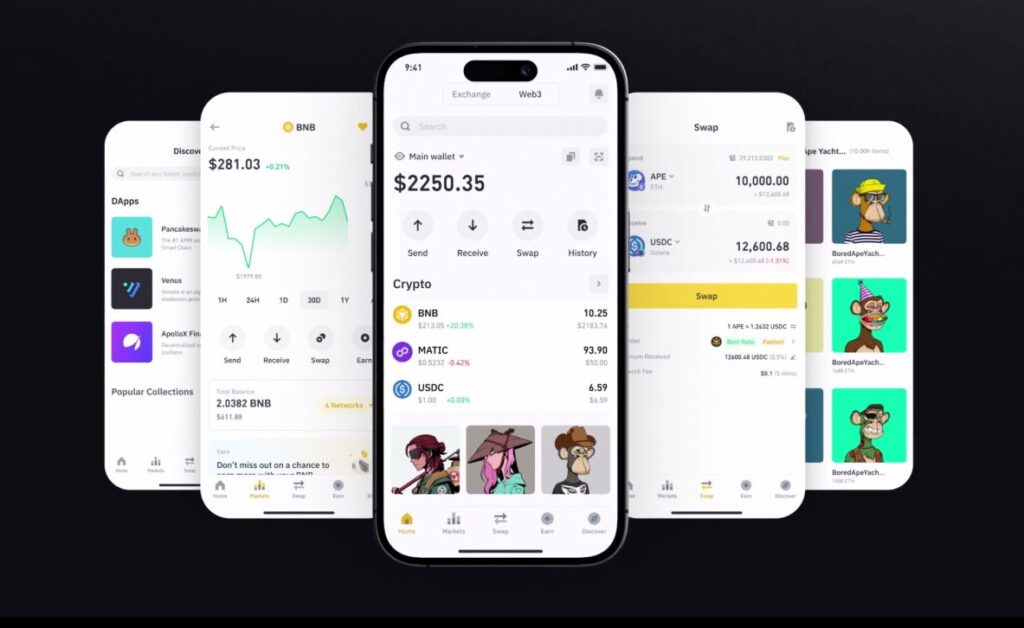
In the world of digital revolution, where the boundaries between reality and virtual space are becoming increasingly blurred, Binance, one of the giants in cryptocurrency exchange, has unveiled another milestone in the evolution of personal finance – the Web3 wallet. This innovation, announced during the Binance Blockchain Week in Istanbul, aims to democratize access to independent custody of digital assets, making it easier for users to explore the emerging world of DeFi from the comfort of their smartphones.
In the modern personal finance ecosystem, where traditional banking systems are undergoing a digital metamorphosis, cryptocurrencies continue to gain significance as investment and payment tools. In this context, Binance, a leading cryptocurrency trading platform, has revealed its latest tool – the Web3 wallet, available directly in the Binance mobile app.
The idea, shared with the audience by Changpeng Zhao, also known as “CZ” and the CEO of Binance, goes beyond the simple concept of storing assets. The Web3 wallet is a key component of the Web3 infrastructure, enhancing users’ financial sovereignty. In a world where digital means of payment are becoming increasingly important, the ability to manage one’s own assets becomes a fundamental issue.
Binance’s innovation is reflected in the use of multi-party computation (MPC) technology. This is a method that allows for the division of a user’s private keys into smaller segments, called key shares. Dividing the key into three parts significantly reduces the risk of compromise and enhances the security of the system.
Always two out of the three parts of the key will be under the user’s control, which ensures the possibility of self-custody. A Binance representative, in a conversation with Cointelegraph, confirmed that the Web3 wallet is not available to users in the United States, where the Binance.com service does not have its reach.
The application of MPC technology eliminates the fear of losing the seed phrase, which is the key to recovering access to the wallet in case of data loss. In doing so, Binance wants to assure its customers that their interactions with Web3 occur within a secure ecosystem.
Of course, users must still take care of the security of their assets and access to the wallet. As pointed out by a Binance representative, in the event of forgetting the recovery password as well as losing the device or deleting the app, access to the Web3 wallet may be irretrievably lost, as Binance will not be able to restore it.
The key shares are stored in three different locations: the first with Binance, the second locally on the user’s phone, and the third encrypted with the user’s recovery password and saved in a personal cloud space, such as iCloud or Google Drive.
Binance’s interest in expanding its cryptocurrency services comes at a time when the platform’s spot market is struggling with challenges in retaining investors. A report by the analytics firm 0xScope suggests that Binance’s share of the spot market has fallen to 40% in 2023. Meanwhile, the Korean exchange Upbit has seen a significant increase, boosting its share from 5% to 15.3% over the same period. These shifts in the cryptocurrency market are also reflected in the personal fortune of Changpeng Zhao, whose net worth, according to the Bloomberg Billionaires Index, fell by 38% due to market downturns.
Such dynamics in the digital finance industry indicate continuous evolution and the need for innovation. Binance, by introducing the Web3 wallet, strives not only to respond to these challenges but also to facilitate users’ access to the increasingly complex world of decentralized finances. As a result, users receive a tool that may facilitate the management of their own funds in a way that is both intuitive and secure, which could represent another step towards full financial autonomy.
